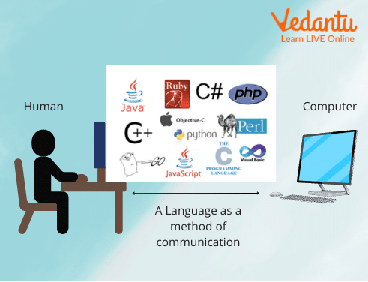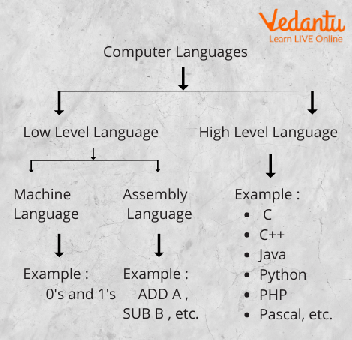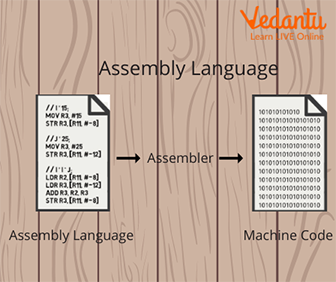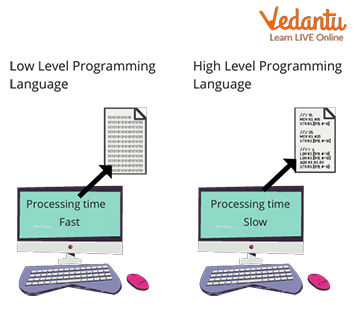Computer Language - A Way to Talk to a Computer!
Humans need a language like Hindi, Telugu, English, or any other regional language or just a body gesture to tell things, express feelings and to communicate with others. Have you ever wondered how we talk to computers? Isn’t it mysterious and exciting?

Human Computer
A computer cannot understand human languages directly. So, we need a language to communicate with a computer. We developed several languages as a method of computer communications. Simply, the languages which are used to communicate with a computer are called computer languages.
Definition of a Computer Language
A computer language is a group of instructions that are used to create computer programs. This is the brief of computer languages. The main goal is to achieve human-computer interaction.

kids Interacting with Computer
Types of Computer Languages
Different types of Computer languages are given below.

Types of Computer Languages
Low Level Language: A Low-level computer language includes only 1’s and 0’s. This language was used in first and second generation computers. A Low level language is very easily understood by a computer but hard to understand for Humans.
Low level languages are designed to interact with computer hardware, which are categorized into two types: Machine level language and Assembly level language.

Computer Languages
Machine Language: As discussed above, Machine level language is a type of Low level language. Machine language is considered to be the oldest computer language. Machine language is developed by only using binary numbers i.e., 0 and 1. So, the instructions or the statements in this language use a sequence of 0’s and 1’s.

Machine Language Code
Assembly Language: Assembly level language in computer programming has evolved with the advancements in the machine language. Assembly language uses symbols, which are popularly known as mnemonics in computer terminology to write the instructions. So, comparatively writing a program in Assembly language is more understandable to the Human than Machine Language.

Processing of Assembly Language
The Assembly language code will be converted into a Machine language code with the help of an Assembler so that the computer can understand the binary converted Assembly Language.
High Level Language: High Level computer languages are the advanced development languages in the evolution of computer languages. These languages are designed to make the programming easier and less error-free.
High level language uses words and commands along with symbols and numbers.
The keywords used in High level languages are similar to English words and can be easily understood by Humans when compared to a Low level language.
Types of programming languages in High level languages are:
C
C++
Java
Java Script
Python
C#
PHP

High Level Programming Languages List
The above given computer languages list are a few examples but there are many other computer languages. Each of these languages have their own syntax (structured statements) and keywords.
Difference Between High-Level and Low-Level Computer languages

Low Level and High Level computer Languages
Important Terms Used in Computer Languages
Statement: A statement is telling a computer on how to do a desired action using words or instructions.
Syntax: Syntax is the structured arrangement of statements.
Algorithm: Algorithm is a set of instructions written to solve a problem. It's the logical thought process of a computer.
Binary numbers: Binary numbers are a way of expressing data. The numbers 1 and 0 are called binary numbers. Computers can only understand binary language. Computers can be able to process millions of 1’s and 0’s.
Coding: Do you know “what is computer code”? Coding is the process of creating computer instructions. Computer codes are also called Programs.
A simple C language code to print a statement is given below.
Debug: Debugging is the process of finding and removing errors from a code.
Assemblar: An Assembler is a computer program designed in such a way that it converts mnemonics to 0’s and 1’s.
Summary
Learning about programming languages is extremely interesting as it gives a way for the technology-driven society we are living in today. Programming languages have come a long way from early machine codes to the human-readable code that now leads our favorite technologies. Computer programming will continue to evolve in the same way that it has for the past few years, keep learning the computer languages and it will be exciting to watch what the future holds.


FAQs on What are Computer Languages?
1. What is meant by a Computer Language?
A computer language is a method of communication that humans use to tell computers how to execute specific tasks. Using these languages, we write programs that do required tasks using a specific coding syntax.
2. How to teach Coding to Kids?
Kids can start learning coding in their early ages like starting with the basic computer parts from their kindergarten based on their own interest. Encourage your kids by showing them computer parts and simple computer programs which give interactive outputs and make them engaging. Parents can use several online resources developed to teach coding for their children.




